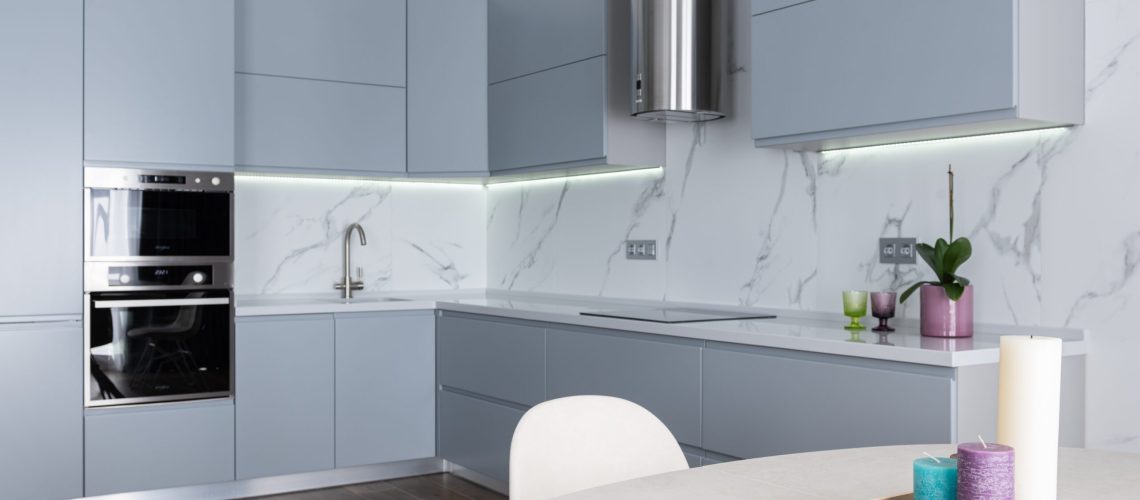In the kitchen, one feature that immediately catches people’s attention is the cabinetry. Since they are very visible, cabinets need to be in pristine condition all the time.
Flaking or peeling paint definitely makes your cabinets look unattractive. It can even make them look untidy, which isn’t a description you would want to be associated with the space where you prepare your food.
Fortunately, resolving this problem won’t have to cost an arm and a leg. Spray painting kitchen cabinets is an excellent alternative to buying new ones. The latter is undeniably the more expensive option.
What Does Spray Painting Kitchen Cabinets Mean?
Spray painting is an affordable yet effective way of improving the look of your cabinets. It is currently a popular painting method, especially for this kind of project.
One of the reasons why using a paint sprayer is preferred by many, even by professionals, is that it makes the job easier. With this method, paint is applied faster. As a result, the time needed to complete the project is significantly shorter than brush painting.
Moreover, even if the job is accomplished fast, the quality of the output does not suffer. You can expect a smooth finish that can last many years.
However, achieving a high-quality paint job can be challenging for DIYers or amateurs. Failure to use the right tools and techniques can easily result in a poor finish.
Unless you are adept with this method, it is best to let professional painters re-spray your cabinets to ensure that you get a beautiful and durable paint job.
Steps in Spray Painting Kitchen Cabinets
Prep, prime and paint – the major steps involved in spray painting kitchen cabinets. If you are interested in how this painting method is done, read our guide below:
Prep
The first step is to clear the kitchen, especially the immediate area surrounding the cabinetry. Also, empty all the cabinets.
It is necessary to disassemble the cabinets – i.e., remove the doors, drawers and hinges. The hardware for each cabinet – screws, hinges, handles – should be placed in a container. Label the container to avoid confusion when assembling the cabinet later on.
Scuff up the cabinet frame, doors and drawers using sandpaper to remove old paint. The goal is not to completely strip off the old paint layer but to bring down the sheen.
Fill the dents using wood putty or filler and putty knife. Let the filled areas dry. Then, sand down the wood putty to level the surface.
Clean the cabinet doors, drawers and frame to remove grease, grime and dirt. Pay special attention to areas near the stove or oven. It isn’t easy, but you need to rid the surface of grease or oil. Otherwise, the primer won’t stick well to the surface. A degreaser or TSP can be very useful in this task.
Like all other paint jobs, the prep work is the most laborious part of the process. But once that’s done, everything else is a lot easier.
Prime
When the cabinets are completely dry, you can proceed to apply the primer.
Before you start priming, mask the entire kitchen area using painter’s tape, paper and drop cloths. Ensure that everything that does not need to get painted on is covered. Also, set up a workstation where you’ll be painting the doors and drawers.
Fill your sprayer with primer. Make sure to follow the manufacturer’s directions.
Spray the primer on the cabinet frame, doors and drawers. One trick you can do is to put hooks on the doors and drawers to hang them. This makes painting and drying a lot easier. It also helps in ensuring that the paint is sprayed on the surface evenly without any visible strokes or texture.
Tip:
You can use a fan to improve the ventilation inside your kitchen. It can help diffuse the fumes when you spray.
Paint
Make sure that the primer is dry before you apply the paint. You must observe the manufacturer’s recommended drying time.
Before painting, practice using the sprayer first on a test surface or a piece of paper. Adjust the pressure settings accordingly and make sure it is not too high.
Spray the paint from a distance of around 30 cm from the surface. Do it slowly and gently. Rushing can lead to splatter and drips. It will also create areas with too much paint, resulting in an uneven finish.
When working on the cabinet frame, coat the vertical surfaces gently to minimise drips.
Let the paint thoroughly dry before applying the next coat.
While waiting for the paint to dry, you can clean the hardware. You can use metal polish to clean the metal hardware. For plastic handles, you may use a brush and soap.
Ensure that all parts are completely dry before reassembling the cabinets. To avoid leaving fingerprint marks on the surface, wait for 24 hours before putting them back.
Remember, kitchen cabinets that are spray-painted properly will last for at least 8 years before a new coat of paint is needed. So, spray painting kitchen cabinets definitely work when it’s done correctly.
Is it time to repaint your kitchen cabinetry? Our professional painters are experienced in spray painting kitchen cabinets. Call us on 086 608 1817 / 085 139 0233 to get a free quote.
